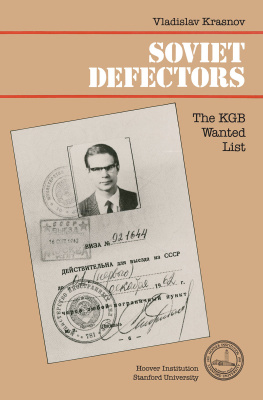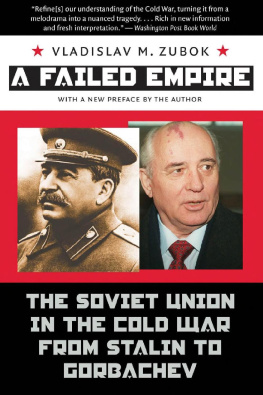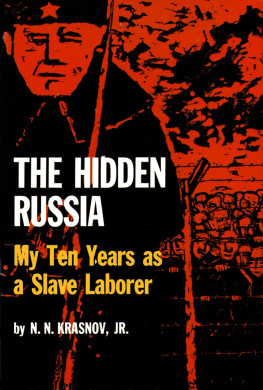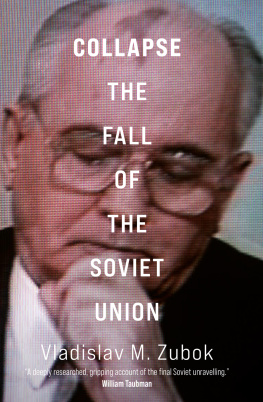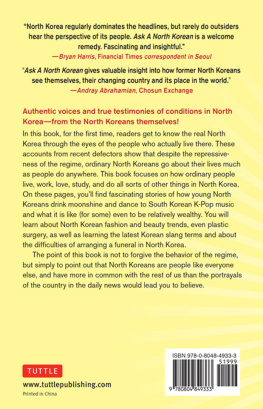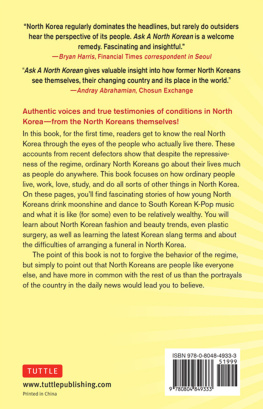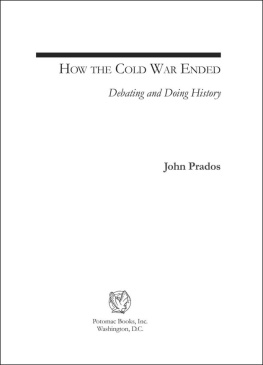The Hoover Institution on War, Revolution and Peace, founded at Stanford University in 1919 by the late President Herbert Hoover, is an interdisciplinary research center for advanced study on domestic and international affairs in the twentieth century. The views expressed in its publications are entirely those of the authors and do not necessarily reflect the views of the staff, officers, or Board of Overseers of the Hoover Institution.
Hoover Press Publication 323
Copyright 1985 by the Board of Trustees of the
Leland Stanford Junior University
All rights reserved. No part of this publication may be reproduced, stored in a retrieval system, or transmitted in any form or by any means, electronic, mechanical, photocopying, recording, or otherwise, without written permission of the publisher.
First printing, 1986
Manufactured in the United States of America
90 89 88 879 8 7 6 5 4 3 2
Library of Congress Cataloging in Publication Data
Krasnov, Vladislav.
Soviet defectors.
Bibliography: p.
Includes index.
1. Civil rightsSoviet Union. 2. DefectorsSoviet Union. 3. Political persecutionSoviet Union. 4. Soviet UnionPolitics and government1945-
I. Title.
JC599.S58K73 1985323.4092285-17661
ISBN 0-8179-8231-0
ISBN 0-8179-8232-7 (pbk.)
F OREWORD
How odd it is that the Soviet regime has drawn near to the biblical age of three score years and ten without, until the publication of this book, a single scholarly work on defection by its subjects having appeared. Vladislav Krasnov is thus a pioneer in a new, small, but important area of Soviet studies.
He is an admirable pioneercalm, fearless, objective, literate, numerate, systematic, undeterred by obstacles or sacred cows. He knew what he wanted to do and set about doing it. The result, as readers will see, is rewarding. But he rightly insists that his treatment is far from exhaustive.
To start with, Krasnov wisely limits himself to the period since 1945. This makes the topic manageable and leaves the earlier Soviet years, when defection was an equally sensitive issue, to a pioneer of the future. Beyond this, painstaking research in a dozen or so countries around the Soviet periphery would clearly build up more complete data on defection, to supplement what Krasnov has accumulated on 470 individuals for 1945-69 and on approximately 200 individuals for 1969-84. Regarding the former period he was able to exploit a lucky break: a top-secret list of defectors and Western agents for whom the KGB was searching had fallen into the hands of an emigre organization. But for the years 1969-84 he had to rely mostly on the information he could gather from various press sources.
In his mapping of this neglected territory, Krasnov is suitably methodical. He defines with precision what he means by a defector; he surveys, briefly but vividly, the present literature in the field, which consists mostly of defectors memoirs; he examines the attitudes and motivations of the principal parties involvedthe defectors themselves, the receiving governments, and the KGB; he discusses perceptively his statistical tables on the age and nationality of defectors, their year and method of defection, the countries they choose, their previous occupations, and so on; and here, as elsewhere, he takes care not to stretch his data beyond what they will bear, appealing indeed to future researchers to focus on the many gaps and uncertainties to which he points.
On occasion, Krasnov the objective scholar does not hide his humane values and his critical view of the insensitive or even negligent ways in which governments have sometimes handled defectors. He documents the vulnerability of defectors and their natural resentment when their motives, which are often dissident and patriotic, are unjustly suspected.
In addition, while fully aware of the dangers posed by phony or planted defectors, Krasnov argues convincingly that too little is done to eliminate unnecessary obstacles to defection or to exploit the unique and valuable resource it supplies. If defections and defectors stories were publicized more vigorously, he says, several benefits would ensue. The government of Finland, for example, would come under greater pressure to terminate its present agreement with the Kremlin to return defectors to the USSR. The increased publicity would make it harder for Soviet agents to continue to harass defectors or even sometimes to kidnap or murder them. World peace would become more secure, as interviews, articles, and books by defectors would undermine the effect of Soviet propaganda and have a salutary impact on Western opinion. Finally, defections by senior officials like Arkady Shevchenko and Michael Voslensky might occur more regularly, and this would give the West a better understanding of the Kremlins carefully concealed processes of decisionmaking.
We might note here in passing that in 1983 The Jamestown Foundation was set up in Washington, D.C., to promote goals very similar to those advocated here by Krasnov. Alsoand this is my own long-range speculationif high-level defections become more frequent in the years ahead, the cumulative damage done to Soviet diplomacy and espionage, and thus to the morale of the Soviet elite as a whole, could perhaps turn into a tangible factor pushing the leadership toward liberal reform.
This brings me to some final remarks about Krasnovs interpretation of the dynamic trends in Soviet defection. Having demonstrated statistically that the average rate of defection was markedly higher in the drab Brezhnev era than in the more hopeful years of Khrushchev, he speculates that this trend will continue in the future, since the USSRs domestic problems are so intractable.
To my mind, this is persuasive. Since the late 1970s the mood of Soviet society has become increasingly sour and tense. Social, economic, and political problems have mounted; the debilitating war in Afghanistan has dragged on. By 1982, open dissent had become impossible and legal emigration had been virtually halted. As few emigrants and defectors have been returning to the Soviet Union, the message has come through that settling in other countries is at least possibleif only one can somehow get there.
In these circumstances, the desperation in a number of disaffected communities long barred from emigration has been growing. In 1984, for example, the Gorelkin family of Pentecostals from Vilnius took the unprecedented risk of attempting a collective escape on foot, even though two of them were in poor health. Five adult children and their parents (who were approaching 60) trekked for twelve days through the mountains of southern Georgia. Avoiding the border patrols that annually catch hundreds of escapers near the USSRs perimeter, and cutting their way through frontier fences, they miraculously reached Turkey and freedom.
Conceivably, of course, Mr. Gorbachevs Politburo will in due course ease social tensions, restart emigration, reinvigorate the economy, and withdraw the limited contingent of Soviet troops from their temporary duty in Afghanistan. But while such welcome developments might indeed reduce the rate of defection, they would surely not halt it. For as Krasnov suggests in this pathfinding book, defections will go on occurring until the day Russia is free. And that, for the time being, is the stuff of dreams.
Peter Reddaway,
London School of Economics and Political Science


